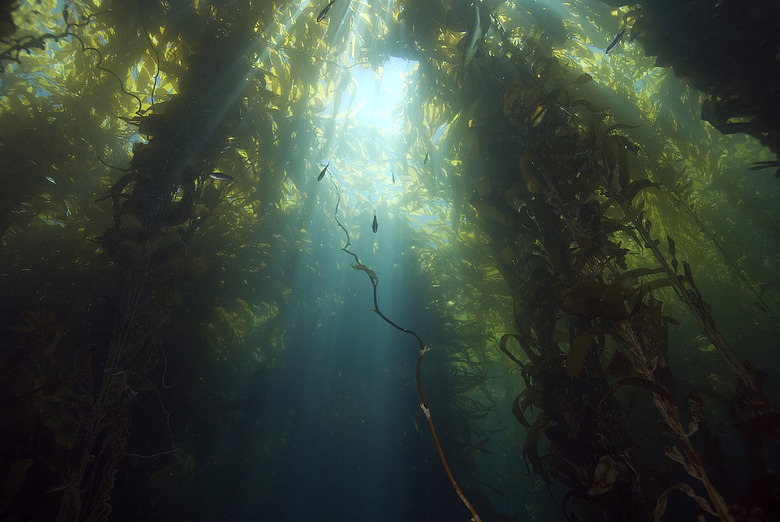How Does Seaweed Conduct Photosynthesis?
"Seaweed" is actually a misnomer because the word "weed" implies that it is a plant. However, because it lacks the vascular system common to all plants, seaweed is actually considered a form of algae. Seaweed can be split into three major groups: green algae, brown algae and red algae, all of which conduct photosynthesis differently.
Green Algae
Green Algae
Closer than any other kind of seaweed to vascular plants, green algae get their color from chlorophyll pigments, predominantly chlorophyll a and b. Both types of chlorophyll absorb mostly shorter, red wavelengths of light that have a tough time penetrating deeper waters. Therefore, green algae is found mostly in shallow water and only 10% of these organisms live in a marine environment. This type of algae may be either single celled or multi-cellular. Like vascular plants, green algae have chloroplasts within their cells that conduct photosynthesis. Interestingly, a certain species of sea slug called Alesia is known to steal these chloroplasts and use them for its own purposes.
Brown Algae
Brown Algae
Green algae may act in a manner similar to vascular plants, but brown algae are probably best known for having an appearance that most resembles vascular plants. These multicellular algae are responsible for the kelp forests that provide food and shelter to countless marine organisms. Although brown algae do contain chlorophyll, they predominantly contain the photosynthetic pigment fucoxanthin, which reflects yellow light. Fucoxanthin is considered an accessory pigment, which absorbs sunlight then passes this energy on to chlorophyll for processing.
Red Algae
Red Algae
Red algae are probably the least similar to vascular plants, but these organisms comprise the majority of seaweed species. Although these organisms contain chlorophyll, they get their unique coloration from their two accessory pigments: the bluish phycocyanin and the reddish phycoerythrin. These pigments absorb longer, bluish wavelengths of light and this allows them to grow in deep waters where longer wavelengths of light can penetrate. These algae can also grow in shallower, tidal waters and — if they overgrow into a massive algae bloom — are known for causing the deadly phenomenon known as a red tide.
Uses of Seaweed
Uses of Seaweed
Although a red tide can be devastating to coastal industries, seaweeds are largely beneficial for society. Many species of algae are harvested as food products, including sea lettuce (green algae) and nori (red algae). Many brown algae species are used as food additives, cosmetics or fertilizer for terrestrial plants. Scientists are currently researching the pigments found in red algae for use as chemical tags. When bonded to antibodies, these tags can be used to identify cancerous cells.
Cite This Article
MLA
Smith, Brett. "How Does Seaweed Conduct Photosynthesis?" sciencing.com, https://www.sciencing.com/seaweed-use-photosynthesis-5786854/. 24 April 2017.
APA
Smith, Brett. (2017, April 24). How Does Seaweed Conduct Photosynthesis?. sciencing.com. Retrieved from https://www.sciencing.com/seaweed-use-photosynthesis-5786854/
Chicago
Smith, Brett. How Does Seaweed Conduct Photosynthesis? last modified March 24, 2022. https://www.sciencing.com/seaweed-use-photosynthesis-5786854/
